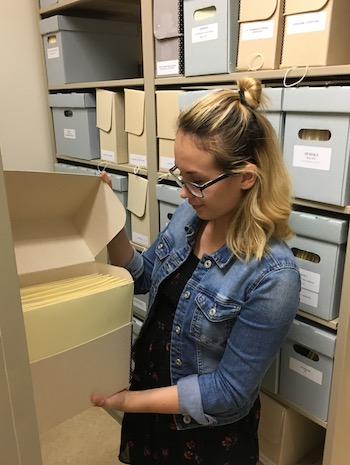
Anna Bodnar in the Archival Collections Room
Young Canada Works in Heritage Organizations is a summer job program for students. It offers them the opportunity to improve their skills while acquiring practical knowledge in a heritage field, such as artefacts preservation, conservation, research, interpretation, promotion or new media by working in a museum, archive, library, cultural centre or heritage site.
We applied for funding for a summer position of Archival Assistant to work on a project at the Bohdan Medwidsky Ukrainian Folklore Archives. The program was administered by the Canadian Council of Archives who were extremely helpful and encouraging on all stages of this project: from applying to reporting. We received the funding, for which we are extremely grateful, and hired a student, Anna Bodnar, who just finished the third year of her Science degree at the University of Alberta. Anna worked full time from June to August on a project aiming to organize ethnographic materials at the Ukrainian Folklore Archives. These ethnographic materials were collected in the field by students in the Ukrainian Folklore Program at the UofA and other researchers from mid 1960s to 1990s. They document cultural expressions of Ukrainian Canadians (customs, traditions, rituals, community life) in various formats: audio interviews, photographs, field notes, essays, and other records.
Here is how Anna described her experience at the Kule Folklore Centre:
This summer I had the privilege of working at the Bohdan Medwidsky Ukrainian Folklore Archives. Throughout my summer I was given many tasks including rehousing ethnographic student works into acid-free folders to be placed into the Archival Collection Room, digitally inputting new accession numbers into applicable software, and adding descriptions of ethnographic collections into the database. Each task had its own unique challenges and different methods of execution. Digitally inputting information about records using software helped me to develop my transliteration skills and helped me advance my Excel knowledge. Describing ethnographic collections was also a foreign territory for me. I was able to successfully navigate through the database AtoM and process over 180 accession numbers. Furthermore, I created a step-by-step guide for other archival assistants to follow to maintain consistency in the database.
Throughout this summer I was also able to help on smaller projects which increased my skill set in the archival field. I helped with digital media, shelving audio records, and used Mylar to create protective sleeves for photographs.
Not only did I get the opportunity to work on all of these projects, I was also shown other archival institutions through tours. The tours throughout the summer showed me a new insight into the archival world and the differences that come with each archive. Some of the highlights included the Provincial Archives of Alberta (PAA), the City of Edmonton Archives, Edmonton Catholic Schools District Archives, and the Catholic Archdiocese Archives. Each of them had their own unique flair and specific concerns. One of the most memorable moments was seeing the intricacies in artifact restoration at the PAA and observing the great number of staff members there work in each department.
Overall this summer has shown me a glimpse into the heritage field I had little to no knowledge of previously and provided me with amazing experiences. I tremendously enjoyed enhancing my Ukrainian involvement and working with everyone at the Kule Folklore Centre.
Anna Bodnar